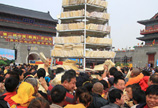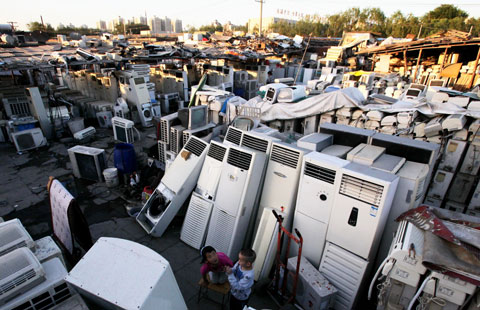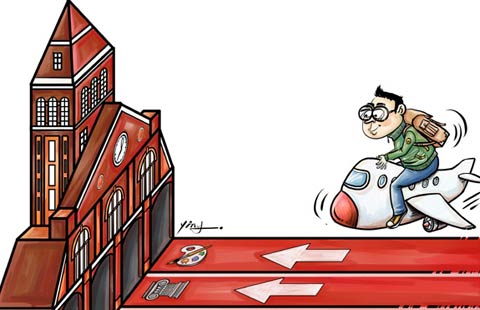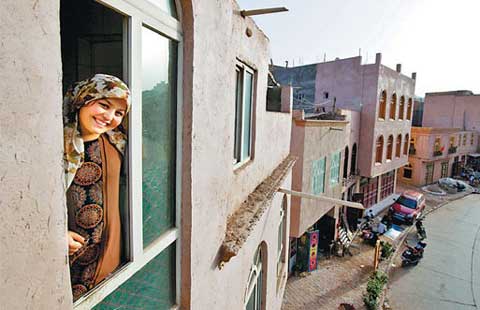Crop you can count on promises harvest
By Zhang Yuwei (China Daily) Updated: 2012-07-16 10:41Last year Zhang shipped about 50,000 tons to China in the form of double-compressed bales, compared with 5,000 when he started his business five years ago.
"It's hard to believe that it actually may cost less to ship from Long Beach, California, to cities in China than to ship between cities in China," he said.
Zhang's company, Lu Tian Yuan, is based in Beijing's Changping district. It employs roughly 300 people in three factories in the capital and in Inner Mongolia and is one of the oldest and biggest suppliers of alfalfa pellets in China. Its clients include well-known Chinese dairy brands, according to Zhang, although he declined to name them, and customers in Japan and South Korea.
Despite the increasing need for alfalfa hay to feed dairy cows, the rapidly decreasing quantity of arable land in China has affected production of the crop domestically, said Zhang.
"It's true that not all dairy producers can afford high-quality alfalfa, but paying a bit more can increase the output and quality of dairy products, which will eventually create sales value for the producers," Shao said.
Increasing the proportion of alfalfa to about half of a cow's diet is a good way to boost protein levels in milk to the international standard of 3.2 percent (compared with China's current 2.8 percent) or higher, said Lu Xinshi, a professor at Beijing Forestry University. "Alfalfa in the diet can also help extend a cow's milking life and increase the quality of the dairies," Lu said.
As owner of the Utah ranch, Zhang is legally an alfalfa hay provider and can conduct business with processors in the US directly, making his business sustainable, as he put it.
"We have seen the price increase from about $200 a ton two years ago to more than $400 a ton last year," said Shao. "It looks good and may still be on the rise."
To supply its growing dairy industry, China bought 96,000 tons of alfalfa hay from the US in the first quarter of this year, more than half the total in 2011 and 200 percent higher than in the first three months of last year, according to the Livestock Marketing Information Center in Denver.
"China's buying patterns will likely be highly dependent on their domestic forage production. The faster forage production meets demand in China, the less China will need to source forage from the US and other countries," said Katelyn McCullock, a dairy and forage economist with the center, which connects USDA economists, industry representatives and university agricultural extension agents.
The top export destinations for US alfalfa include Japan, the biggest buyer, and South Korea. Meanwhile, China and the United Arab Emirates have become fast-growing markets for the crop in recent years, according to the USDA.
Explosive growth
"The last three years have seen explosive growth in alfalfa hay going to China," McCullock said. "It is doubtful that the Chinese will continue to buy at such a high growth rate long-term. However, it remains difficult to predict the domestic forage-supply situation in China or when exports will slow down."
Zhang, who had just returned to Beijing after visiting Utah, said he aims to obtain 40,000 to 50,000 tons of alfalfa this year, partly through crop purchases from nearby farms. That, he predicted, could translate into "more than $1 million" in income.
Escalante's location in a basin between mountain ranges makes it ideal as a grazing spot for several species of wild game. In late summer and early fall, deer and elk migrate to the ranch seeking abundant food and space. That's when the hunting season starts, said Zhang, who plans to develop a hunting business when the alfalfa harvest ends this fall.
"The lodge on the ranch is well-equipped and can accommodate about a dozen people at a time," he said.
Meanwhile, his hunt for additional farmland will continue. "I am looking at more farms now, in Utah and other states and am considering buying more."
Contact the writer at yuweizhang@chinadailyusa.com
- Seven villagers murdered in N China
- China steps up tobacco control efforts
- Five jailed for separatism in Xinjiang
- Letter asks for leniency in poisoning case
- Antibiotics in surface water pose 'indirect health risk'
- Tianjin airport opens up transit link to Beijing
- High levels of antibiotics in China's major rivers
- China to dig tunnel for Asian rail system
- Bering strait line to US possible, experts say
- China: Stop oil rig harassment







